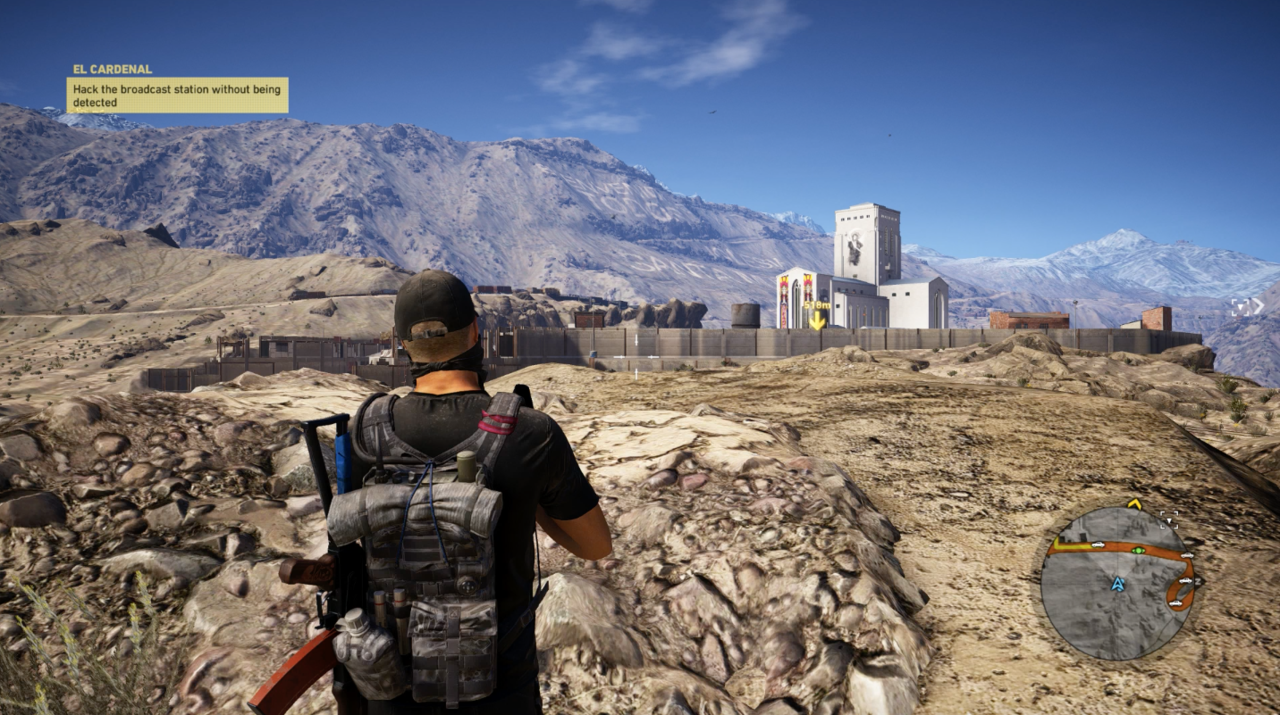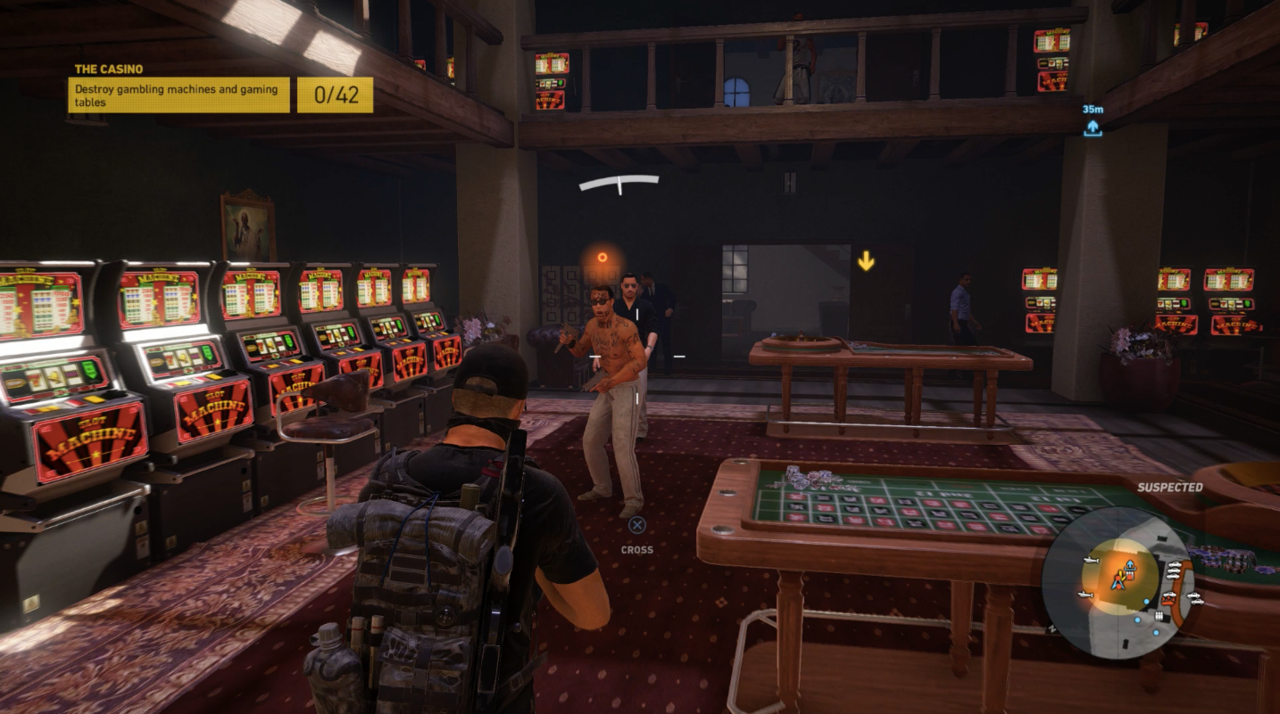Ghost Recon: Wildlands is a squad based Tom Clancy game that plays by the numbers. It stays true to the series' Rainbow Six-inspired roots, emulating the cold and calculated nature of organized infiltration and coordinated stealth kills. Whether you're syncing shots with friends or an AI companion, there's gratification in taking down targets efficiently. Unfortunately, the adherence to this specific kind of gameplay gets lost and diluted in Wildlands’ vast expanse of Bolivia.
By Tom Clancy standards, Wildlands' story--a revenge tale disguised as a narco-state destabilization operation--is low hanging fruit. Worse yet, the narrative perpetuates the notion that a cartel is only worth taking seriously when one of your own has been tortured to death, ignoring the thousands of locals who've suffered similar fates.
It's easy to tell that Karen Bowman--your CIA field handler--has a personal vendetta against the Santa Blanca, the drug cartel that rules Bolivia. When you ultimately come face to face with El Sueno, the cartel's kingpin, you can spot the payoff a mile away. At the end, there's no poignant message or lesson regarding this latest Tom Clancy episode in American interventionism. El Sueno himself has the privilege of introducing his side of the story right when you launch Wildlands. His introductory monologue and his subsequent speeches justifying his twisted sense of morality sounds like the rationalizations of someone who grew up in a bedroom with posters of Michael Corleone and Walter White.

The pursuit of a single lead that Karen provides conveniently results in a series of other clues and each one of those tip-offs blossoms into others. Enough successful missions eventually results in confrontations with underbosses and lieutenants who are less than six degrees away from El Sueno. Wildlands is as much about gathering information on your targets as it is about picking what leads to follow down their respective rabbit holes. With a keen eye (and enough luck), you can avoid having to complete every missions related to a given boss and eliminate them ahead of schedule.
As you travel from lead to lead, you're exposed to the various factions that pepper Bolivia. On your side are the rebels, known as the Kataris 26. Enforcing El Sueno's rule are the Unidad, Bolivia's military police. These groups add character to your surroundings and how intrusive they are with your mission goals depends on you. You can curry favor with the rebels and gain their support by completing side missions and marking valuable resources for them. And as long as you're flooring it in a vehicle, any Unidad you drive by will sit tight, rather than follow in pursuit.
Some of your intel will reveal locations of weapons to add to your collection, though amassing a stockpile of firearms is purely optional. Compared to the multitude of games where the acquisition of guns is a major selling point, Wildlands’ selection is serviceable. The problem is that you can easily complete the game with your initial load out. This is because you regularly earn skill upgrades by completing missions, and you gain access to the quintessential stealth weapon--the silenced sniper rifle--early on. There's little incentive to hunt for other weapons unless you're a gun nut or you enjoy the experience of mixing up different weapons.
Along with the obvious discretionary benefits of the aforementioned silenced sniper rifle, the drone--even before you've upgraded its capabilities--is an exceedingly helpful tool. It's the catalyst to Wildlands' mark-and-execute mechanic, the same feature that's been the hallmark of last few Tom Clancy games like Splinter Cell: Blacklist and Ghost Recon: Future Soldier.
For the fans who've been hooked on Ghost Recon for the advancing technologies--which has been integral with the series' brand--the lack of gadgetry in Wildlands will prove disappointing. The novel appeal of drones--particularly in Tom Clancy games--has long since expired. While you can upgrade it with a handful of offensive and diversionary capabilities, its default function as a target-marking device is all you need.
While the drone marks your targets, it's your squad's responsibility to pull off the kills. The need for coordination underscores the team-based appeal of Wildlands, which can be experienced with AI-controlled teammates or, preferably, with other players. When playing with skilled friends, there’s comfort in knowing that you’ll most likely be on the same page. Playing with AI has it’s own benefits, like being better bullet sponges when they’re out in the open healing you. The one puzzling omission to multiplayer is the ability to form a mixed squad of friends and AI; if you're playing only with one buddy, you're stuck as a pair. Even so, it's wholly amusing that the whole squad's ongoing situational story-driven banter persists even when you're just a duo.
Wildlands' most gratifying moments come from playing the ghost. It means having the patience to spend minutes surveying a stronghold from a distance and arming yourself with that visual information to confidently infiltrate the base. There's a rush in leaving the base quietly with the intel you're assigned to uncover or--even more challenging--the VIP you're sent to rescue. And it doesn't get any better than pulling off these stealthy missions on your first try.
Equally thrilling are the moments where you have little time to adapt to changing circumstances. When the best laid plans go wrong, when you've been spotted and a base is on high alert, you're treated to one of the few instances where your squadmates' moment-to-moment updates are actually useful. When a high value target is fleeing, your team will let you know. Suddenly, a foot pursuit ensues and you're left ignoring all the chaos and gunfire around you. The resulting car chases prolongs the excitement, unless you're lucky enough to grab the target right before he finds a getaway vehicle.
At the outset, its appears that Wildlands' strength is in its diverse mission types. For every assassination, there’s a capture or rescue assignment. Any given sortie might involve hacking, sabotaging, or even stealing a plane. You might even find yourself pulling off the ol' switcheroo with two similar looking trucks. It’s never a dull moment, at least for the first 20 or so hours. By the time you've experienced each of these kinds of objectives a handful of times, boredom starts to set in.

This encroaching sense of monotony feels more apparent as the poorly written squad chatter starts to repeat itself. When your teammate complains about not being allowed to man the boat, it’s mildly amusing the first time, so you can imagine how annoying it would be hearing the same gripe the twentieth time. Even incorrect situational commentary, say when you’re alerted to a patrol chopper while you’re deep inside a mine stops being funny before long.
Ubisoft's reimaging of Bolivia is tailor made for goal-driven excursions beyond the story. Often times, it's photo realism is eye-catching, like when the sunlight glistens off a watery tire tracks. Other times, seeing nothing but jungle or an endless ridgeline of beige rocks brings out the blandness of some regions.
The mix of dense vegetation and barren mountains echo the environments of Metal Gear Solid V: The Phantom Pain, just less accommodating. Navigating your way down a rocky cliff on foot is as unpredictable as climbing one. Instead, you're left using vehicles as your most reliable means of traversal. Yet for a map that should be more off-road friendly, this interpretation of Bolivia often encourages you to keep to the beaten path, lest you wipeout after a sick cliff jump on a motorcycle.
One unsurprising benefit of the open environment are the myriad avenues for infiltration into any enemy stronghold. No matter how fortified a four-sided base is, there is always a backdoor, whether it's a broken fence and a convenient stack of boxes next to the outer wall. Finding and using these alternate entrances can be as satisfying as any frontal assault.
Despite the country's vastness, it's a mixed blessing that you don't need to visit every region to take down El Sueno. Whether you take the most direct route to the boss or you systematically cross off every underboss and lieutenant first, you'll confront a rogues gallery of diverse personalities, whether that's a social media savvy Santa Blanca evangelist or an American military ex-pat who found purpose in El Sueno's cause.
As only the second open world game in the Clancyverse, Ghost Recon: Wildlands is a middlingly safe tactical shooter and a slightly wasted opportunity given the ambitious scope of its seemingly boundless map. While its main strength is its mission diversity, it doesn’t take long to lose the motivation after reaching El Sueno's doorstep. Even with a foursome of highly trained friends, Wildlands eventually reveals its diminishing returns. The feeling of positive immediacy and dopamine hits begin to wane sooner than you expected from a game with such a large and diverse world.



















